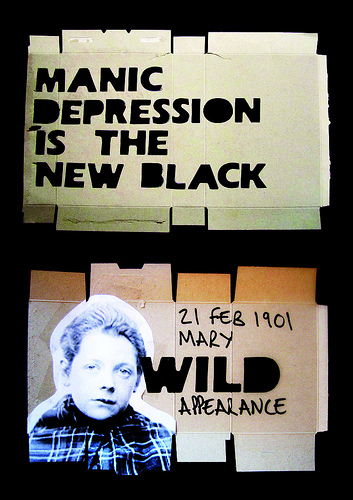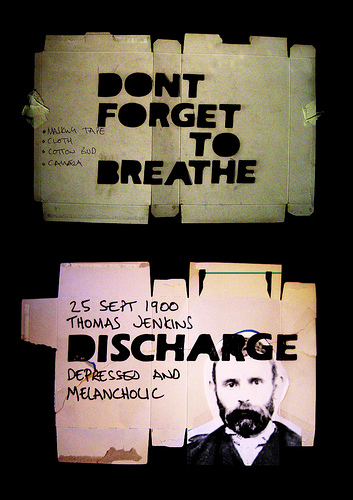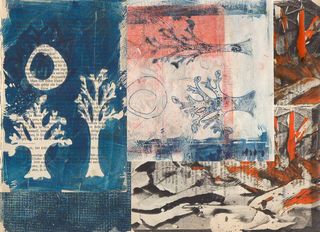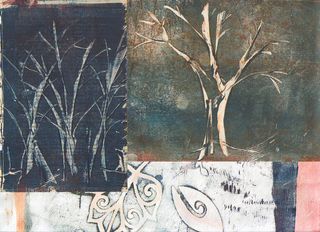I don’t want you to come away from these rants thinking I hate scrapbooking and all their supplies. In fact I used to say, often, “Man, I wish art journaling had some cool stuff like that. Why can't they make cool stuff I like?” And then everyone burst onto the scene with all kinds of cool stuff. Brads with tops shaped like screws, both phillips and flat? Check. Scissors to cut paper edges to look like postage? Check. Anyone remember the days of running your paper through a sewing machine to get that postage stamp edge? I sure do. Anyone else buy a junk clock at a thrift store and smash it to get at the gears? Me too! Now you can buy a baggie of gears that are identical to every other bag of gears on the shelf for $5. You can also buy a coordinating, mask, stencil and rubber stamp set. (As well as some good looking Tim Holtz tape, but it doesn’t stick.)
Back when I started out the only way to get a gear rubber stamp was to carve one. Rubberstamping companies didn’t want to make them, now they do, and they sell. Go figure. I still like my hand carved stamps better.
I’m not suggesting that things were better way back when I started out, what I’m suggesting is that we’ve got WAY more tools at our disposal. To the point we get lost in them. I see a lot of stuff out there where people are using the tools exactly as the manufacturer intended. They lay out a set of rules and everyone follows them. What I’m suggesting is this: Break the rules. Look at the “manufacturers suggested uses.” Then do one thing not suggested with that product. Try something they tell you NOT to do. Obviously nothing unsafe, but you get what I mean, if it says don’t mix with water, do it. If it says not for use on plastic, put it all over something plastic and then press a sheet of paper onto it. Try some things the manufacturer doesn’t suggest. Ask yourself, “WHAT IF.” Over and over and over again. If it doesn’t work you can always flip the page, gesso over it, or write about the problem and figure out a way to make it not happen again, or if it’s a really happy accident make it happen again.
When buying a new product the first question you should ask yourself as an artist and craftsperson is: “How can I make this do what I want it to do?” Then you should set about making it do what you want. If you can’t make it do what you want, consider a different product.
Do you know how hard it was to find a bone folder in 1998? I remember looking all over for one, and finally found one on a dusty back shelf at the Charrette Super Store (sadly now closed). Until I found that bone folder I used 2 glued together hardwood popsicle sticks that I sanded smooth. I made do with what I had access to and improvised until I could afford and find what I needed. Sometimes you gotta do what you gotta do.
Back in high school I signed up for chemistry class. The guy teaching it clearly loved the subject and was brand new to the school. Well, the teacher who had been there for a long time had cherry picked the best students. So Mr. NewGuy got everyone else, including me. I think getting a class full of the “rejects” kinda bummed him out. He ran his class differently, I don’t want to call it a free-for-all but it was. In the end I did better in that class than my classmates in the more structured class. I expect it was because I was allowed and encouraged to ask, “What if” a lot. That class (as well as growing up on a farm with both my parents being teachers) really instilled in me the importance of asking, “What if…” and they trying it.
One of the things I’d like to really suggest to you is that everything you put into your art journal doesn’t need to be acid free or archival.
Whoaaaaa.
Yeah I went there.
I load my journals up with all sorts of stuff that isn’t archival- tea bags, boxes from gum, cigarette boxes that blow into my yard, shopping lists I find, packaging I like, and the list could go on.
Am I worried about the stuff rotting and falling apart? Nope.
It’s my sketchbook. It’s meant to be an on going work that I refer to for inspiration.
In college a few of my professors were all about us using acid free and archival materials, suggesting to us that we should work with what we would if we were professionals. This led to a lot of us buying extremely expensive materials and perhaps a bloated sense of self importance about our student work. I’m not saying that student work isn’t good; it’s just not as evolved as what one makes later in life. Fast forward to when I’ve graduated from college and I’m a teacher, we manage to snag Richard Lee to come in and speak to the class and lead a 2 day long papermaking workshop. I absorbed as much info as the students did, if not more. For part of the workshop Richard brought in his sketchbooks. He’d traveled the world and took amazing notes about papermaking and made the most amazing drawings- with a sharpie and colored in with a small traveling watercolor box. His sketchbook were simply amazing. They blew my mind. The covers were cast paper and the inside handmade papers.
One of my first questions for him was, “Sharpie? Are you worried about them being acidic?” He kinda looked at me like I had 3 heads and said, “Nope. I like extra fine sharpies, they dry fast and they are cheap and I don't worry if I lose 'em.”
I pestered him with questions as did the kids until he was bored and we made paper and then books. In that one moment he totally put on end what my professors had been telling me I needed to do and should do for 4 years. Here’s a guy who was a working artist telling me he liked a material because it was cheap and dried fast. It blew my fragile little mind.
My point being, we should be more concerned with making art and less concerned with what it’s made with. Use what you like and as Picasso said, “the archivists will have a job.” Or something to that effect.
I have a whole long tirade about who acid free and archival are really just marketing tools at this point and how really most of that archival stuff you buy at the craft store isn’t really archival unless it’s got the following standard on it somewhere: ISO 11108. There isn’t any regulation to manufacturers slapping the word archival on their product. Also acid free doesn’t mean archival. It means it’s got a ph higher than 7. Another fun factoid, most of the paper produced in the US (or for the US market) is acid free because it plays better with printing inks. You can buy a little pen to test the acid content of your papers; it’s not really worth it though. The more you handle your paper and the more it gets exposed to air the more acidic it gets, eventually it will be acidic. It might take 10, 20, 30 or 50 years but it will show a higher ph level over time. I could really go on and on about this, but my mantra remains, buy the best you can afford, upgrade later. If like Richard you like sharpies go ahead and use them.
If you are new here, this is your first visit, please realize this is a (so far) 4 post rant on stuff. Feel free to head here to read the rest of my tirade. Also, please don't assume that I hate pretty pages or would sneer at your art. This rant is about empowerment not judgement.




